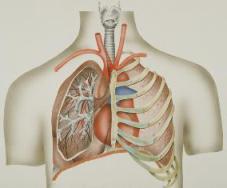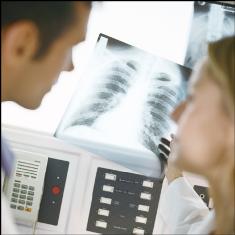Can You Have a Blood Clot in Your Lung and Not Know It
Overview

What is a pulmonary embolism?
A pulmonary embolism is a blood jell in the lung that occurs when a jell in some other office of the body (oftentimes the leg or arm) moves through the bloodstream and becomes lodged in the blood vessels of the lung. This restricts blood flow to the lungs, lowers oxygen levels in the lungs and increases claret pressure in the pulmonary arteries.
If a clot develops in a vein and it stays there, it'due south called a thrombus. If the clot detaches from the wall of the vein and travels to some other function of your body, information technology'due south called an embolus.
If Human foot are not treated quickly, they can crusade heart or lung harm and even death.
Who is at run a risk of developing a blood clot?
People at risk for developing a blood clot are those who:
- Accept been inactive or immobile for long periods of time due to bed rest or surgery.
- Accept a personal or family unit history of a blood clotting disorder, such as deep vein thrombosis (DVT) or pulmonary embolism (PE).
- Have a history of cancer or are receiving chemotherapy.
- Sit for prolonged periods.
People at risk for developing a pulmonary embolism include those who:
- Are inactive for long periods of time while traveling via motor vehicle, train or plane.
- Have a history of center failure or stroke.
- Are overweight or obese.
- Have recently had trauma or injury to a vein, possibly after a recent surgery, fracture or due to varicose veins.
- Are pregnant or accept given birth in the previous half-dozen weeks.
- Are taking birth command pills (oral contraceptives) or hormone replacement therapy.
- Placement of central venous catheters through the arm or leg If you lot have any of these risk factors and you have had a claret clot, please talk with your health care provider so steps tin be taken to reduce your personal take chances.
How serious is a pulmonary embolism?
A pulmonary embolism may dissolve on its ain; it is seldom fatal when diagnosed and treated properly. Nevertheless, if left untreated, it can be serious, leading to other medical complications, including expiry. A pulmonary embolism tin can:
- Crusade heart impairment.
- Be life-threatening, depending on the size of the clot.
Symptoms and Causes

What are the symptoms of pulmonary embolism?
Symptoms of pulmonary embolism vary, depending on the severity of the jell. Although most people with a pulmonary embolism feel symptoms, some will non. The first signs are usually shortness of breath and chest pains that become worse if you exert yourself. You may cough upward bloody sputum. If yous have these symptoms go medical attention right away. Pulmonary embolism is serious but very treatable. Quick treatment profoundly reduces the chance of decease.
Symptoms may include:
- Sudden shortness of breath -- whether you've been active or at residuum.
- Unexplained sharp pain in your chest, arm, shoulder, cervix or jaw. The hurting may likewise be like to symptoms of a heart attack.
- Cough with or without bloody sputum (mucus).
- Stake, clammy or bluish-colored skin.
- Rapid heartbeat (pulse).
- Excessive sweating.
- In some cases, feeling anxious, light-headed, faint or passing out.
- Wheezing.
Information technology is also possible to have a blood clot and not have any symptoms, so discuss your take chances factors with your health care provider.
If you lot take whatsoever symptoms of pulmonary embolism, get medical attention immediately.
What causes pulmonary embolism?
Pulmonary embolism may occur:
- When blood collects (or "pools") in a sure part of the body (usually an arm or leg). Pooling of claret usually occurs subsequently long periods of inactivity, such as later surgery or bed residuum.
- When veins take been injured, such as from a fracture or surgery (specially in the pelvis, hip, knee or leg).
- As a event of some other medical condition, such equally cardiovascular disease (including congestive heart failure, atrial fibrillation and eye attack) or stroke.
- When clotting factors in the claret are increased, elevated, or in some cases, lowered. Elevated clotting factors can occur with some types of cancer or in some women taking hormone replacement therapy or nascence control pills. Abnormal or low clotting factors may also occur equally a outcome of hereditary conditions.
Diagnosis and Tests
How is a pulmonary embolism detected?
Pulmonary embolism is commonly detected through the following tests:
- Computed tomography (CT) scan.
- Lung browse.
- Blood tests (including the D-dimer test).
- Pulmonary angiogram.
- Ultrasound of the leg -- helps to identify blood clots in patients who cannot have an X-ray due to dye allergies or who are besides sick to leave their hospital room.
- Magnetic resonance imaging (MRI) of the legs or lungs.
Direction and Handling
How is pulmonary embolism treated?
Treatment for pulmonary embolism is typically provided in a infirmary, where your condition can be closely monitored.
The length of your handling and hospital stay volition vary, depending on the severity of the clot.
Depending on your medical condition, treatment options may include anticoagulant (blood-thinner) medications, thrombolytic therapy, compression stockings, and sometimes surgery or interventional procedures to better blood flow and reduce the risk of time to come claret clots.
Anticoagulant medications
In most cases, treatment consists of anti- coagulant medications (also chosen blood thinners). Anticoagulants subtract the blood'south ability to clot and prevent future blood clots.
Anticoagulant medications include warfarin (Coumadin®), heparin, depression-molecular weight heparin (such as Lovenox® or Dalteparin®) and fondaparinux (Arixtra®).
- Warfarin comes in tablet class and is taken orally (by mouth).
- Heparin is a liquid medication and is given either through an intravenous (Iv) line that delivers medication directly into the vein, or by subcutaneous (under the skin) injections given in the hospital.
- Depression molecular-weight heparin is injected beneath or under the skin (subcutaneously). It is given once or twice a day and tin can exist taken at home.
- Fondaparinux (Arixtra) is a new medication that is injected subcutaneously, one time a day.
You and your family will receive more data about how to accept the anticoagulant medication that is prescribed. Equally with any medication, information technology'due south important that you lot understand how and when to take your anticoagulant and to follow your doctor'southward guidelines.
The type of medication you were prescribed, how long yous demand to take it, and the type of follow-upwardly monitoring yous'll need depends on your diagnosis. Be certain to keep all scheduled follow-upwardly appointments with your doctor and the laboratory and then your response to the medication can be monitored closely.
While taking anticoagulants, your follow-up will include frequent blood tests, such as:
- PT-INR: The Prothrombin time (PT or protime)/ International Normalized Ratio (INR) test: Your INR will help your health care provider determine how fast your blood is clotting and whether your medication dose needs to be inverse. This exam is used to monitor your status if you are taking Coumadin.
- Activated partial thromboplastin (aPTT): Measures the time it takes blood to clot. This examination is used to monitor your condition if you are taking heparin.
- Anti-Xa or Heparin analysis: Measures the level of low molecular-weight heparin in the claret. Information technology is commonly non necessary to use this examination unless you lot are overweight, have kidney disease or are pregnant.
What are other treatment options?
Compression stockings
Compression stockings (support hose) aid claret flow in the legs and should exist used as prescribed by your doctor. The stockings are usually knee- loftier length and compress your legs to preclude the pooling of blood.
Talk with your doctor about how to use your compression stockings, for how long, and how to care for them. Information technology is of import to launder compression stockings according to directions to prevent damaging them.
Procedures
If a pulmonary embolism is life-threatening, or if other treatments aren't effective, your doctor may recommend:
- Surgery to remove the embolus from the pulmonary artery.
- An interventional procedure in which a filter is placed inside the body's largest vein (vena cava filter) and then clots can be trapped earlier they enter the lungs.
Thrombolytic therapy
Thrombolytic medications ("clot busters"), including tissue plasminogen activator (TPA), are used to dissolve the clot. Thrombolytics are always given in a infirmary where the patient can be closely monitored. These medications are used in special situations, such every bit if the patient's claret pressure is low or if the patient'southward condition is unstable due to the pulmonary embolism.
Prevention
How do I preclude pulmonary embolism?
- Exercise regularly. If yous tin can't walk effectually due to bed rest, recovery from surgery or extended travel, move your artillery, legs and feet for a few minutes each hour. If you know you lot will need to sit down or stand for long periods, article of clothing compression stockings to encourage claret menses.
- Drink plenty of fluids, similar water and juice, but avert backlog booze and caffeine.
- If y'all demand to be stationary for long periods of time, motion effectually for a few minutes each hour: movement your feet and legs, bend your knees, and stand up on tip-toe.
- Do not fume.
- Avoid crossing your legs.
- Do non wear tight-plumbing fixtures clothing.
- Lose weight if yous are overweight.
- Elevate your feet for thirty minutes twice a 24-hour interval.
- Talk to your doctor about reducing your hazard factors, particularly if yous or whatever of your family unit members take experienced a claret jell.
Living With
What is follow-up care after a pulmonary embolism?
Be certain you hash out and sympathise your follow- up care with your dr.. Follow your physician's recommendations to reduce the risk of another pulmonary embolism.
Proceed all appointments with your doctor and the laboratory so your response to prescribed treatments can be monitored.
schneiderolve1987.blogspot.com
Source: https://my.clevelandclinic.org/health/diseases/17400-pulmonary-embolism
0 Response to "Can You Have a Blood Clot in Your Lung and Not Know It"
Post a Comment